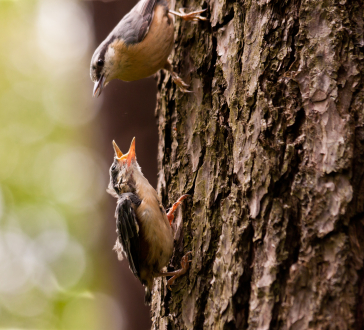-
checking out window bird feeders for baby
It’s not too far of a flight, from the feeders over to the tree bearing the cavity where her babies were raised. Mama nuthatch grabs sunflower hearts quickly feeding her newly fledged babies.
It’s been a really dry, really hot summer thus far. Early July temps feel like the end of August and everything is already parched! More so than aesthetics, this brutal weather has a profound effect on wildlife, including resourceful birds.
More so than usual, roadkill has been rampant, likely many young venturing further out of normal range in search of food and water. Even wild birds do what they need to in order to keep babies fat & happy.
In all the years of backyard birding, I’ve never seen such activity at feeders in the thick of summer (other than nasty common grackles). Natural food sources have been depleted by drought and high temperatures… even the bugs that bug us at dusk are fewer than usual. Gnats and mosquitoes are not as bad, even the pesky fly may have taken a hiatus!
Because of these conditions, adult birds are taking full advantage of backyard feeders… and any kind at that! An adult cardinal was grabbing seed from a platform feeder and passing it along to his baby on the ground below. An adult thrasher was pecking through squirrel mix on the ground to feed her baby in the back along the tree line. This mama nuthatch took about fifteen trips from our window bird feeders over to the familiar tree where eggs were laid and chicks hatched. Scurrying to feed six newly fledged birds, the bird feeders containing sunflower hearts proved to be most welcome.
If you typically feed wild birds, but don’t think it’s necessary in summer… think again! Lots of babies out there with busy parents in search of food to raise their young. Please feed the birds and always, always offer a fresh water source. As simple as a pan of water, or a saucer from an old garden pot will do the trick just fine.
-
finch feeders at 105 degrees
“Oh, I don’t feed birds in summer.“
Have you heard that before? After feeding wild birds for the past 25 years or so – to this day – I still don’t comprehend the statement! It’s up there with dumping the birdbath, turning it over, and rendering it useless through winter!
Sure, natural food sources are usually plentiful through summer… except when temps are reaching and exceeding 105° in most parts of the country, and for days on end! Food sources deplete, disappear, nada, zilch, even mosquitoes at dusk are rarer than in early June. So what’s the big deal? Babies! Parents are scurrying to feed nestlings and fledgelings through a critical growth stage, and in weather that’s just not normal.
Bird feeders have been jam-packed for the last two weeks, we’re going through seed, suet and worms like water! A platform with sunflower heart & peanut mix sees tons of cardinals, jays, nuthatches and titmice. More common with bluebirds, for the first time I witnessed a male cardinal feeding a fledgeling on the ground… from this feeder! Mealworm feeders for bluebirds, with Carolina wrens and thrashers sneaking a few turns, and nyjer seed for finch feeders which have seen hundreds of the electric yellow little birds better known as goldfinches. They actually have the latest nesting season, while Eastern bluebirds are still going strong on their second and third broods. Babies, babies, babies!
So no… you don’t really have to feed the birds through summer, but why wouldn’t you? Lot of babies out there and food sources are becoming quite scarce. Consider setting out a saucer or shallow bowl of water too. Birds will flock to it, more so than the feeders in this heat! Several of our baths are nothing more than large plant saucers on old tree stumps, on the ground, and on the deck. They’re the place to be seen if you’re a bird!
Oh yeah.. and the birdbath thing in winter: That’s why they make bath heaters! Water is essential to life, birds need water in winter, it’s critical even in frigid temps because most of their usual sources (shallow ponds, puddles) freeze over. “Oh, they can just eat snow.” Well, sure they can, but it takes a heck of a lot energy (calories) to convert that snow to water. Help wild birds thrive year-round with wildlife-friendly habitat that makes life better. They’ll make your life more colorfu and interesting too… and that’s a promise!


